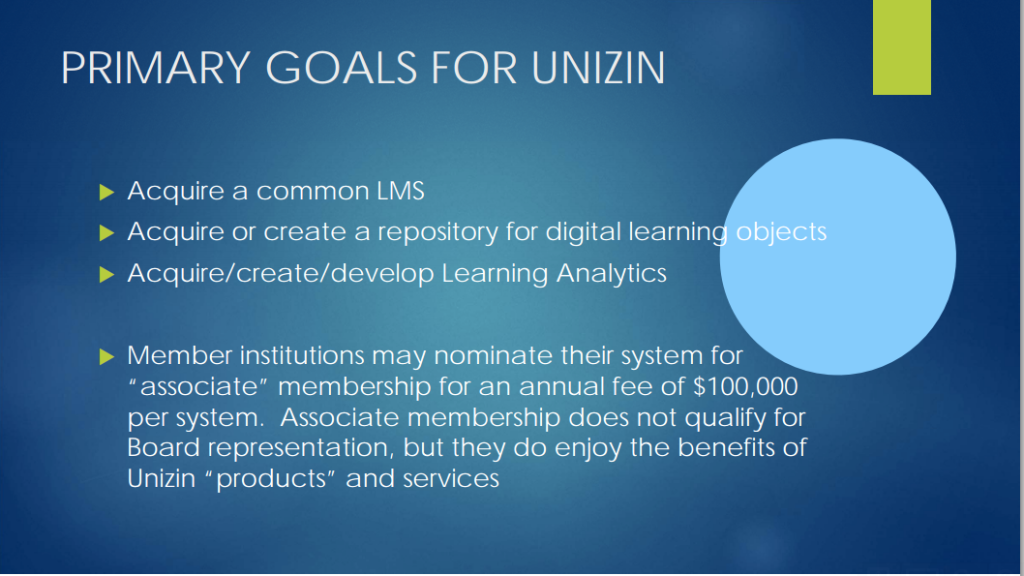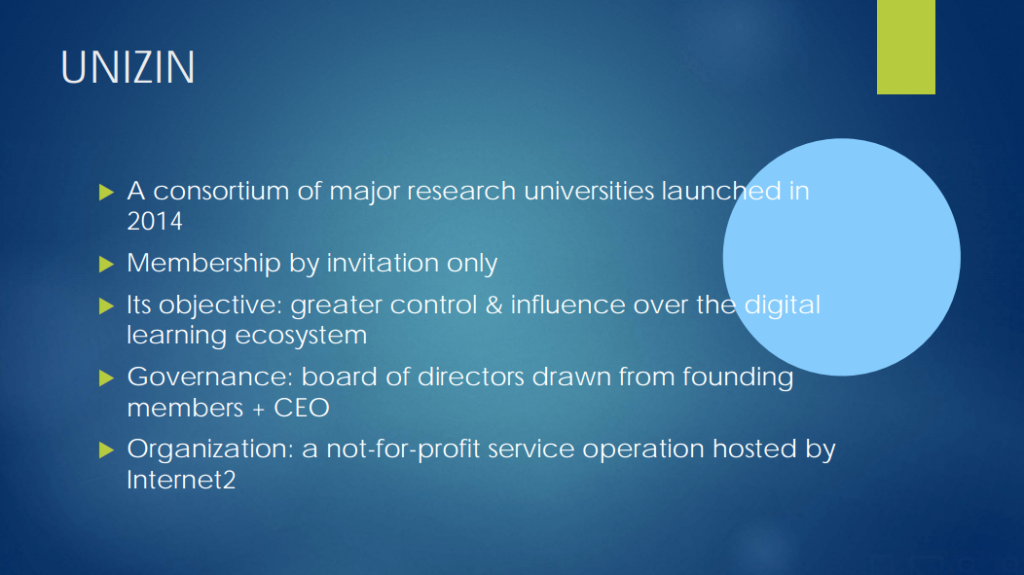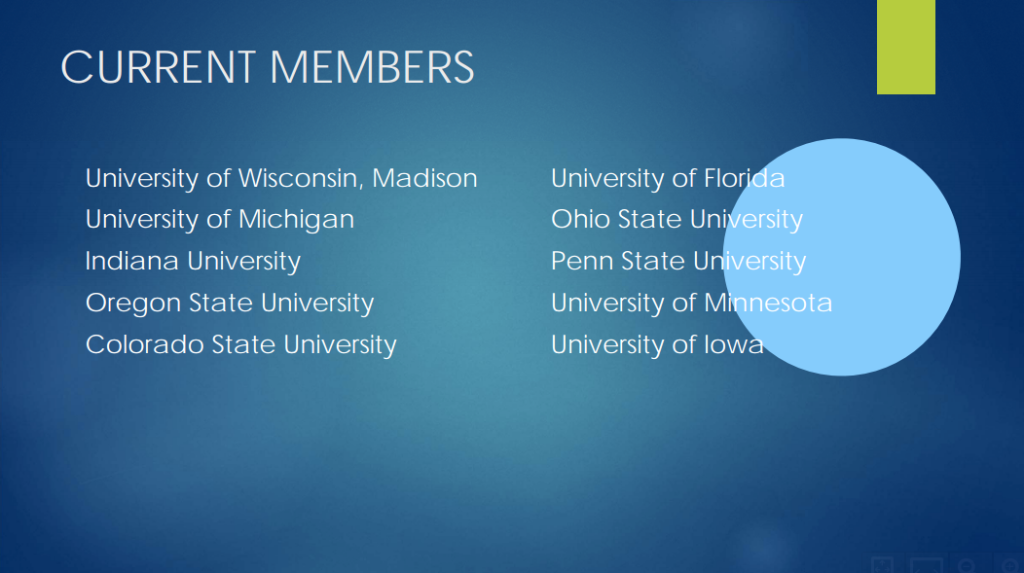Alert unnamed readers prompted me after the last post on the Unizin contract to pursue the rumored secondary method of joining for $100k. You know who you are – thanks.
While researching this question, I came across a presentation by the University of Florida provost to the State University System of Florida (SUSFL) seeking to get the system to join Unizin under these new terms. The meeting was March 19, 2015, and the video archive is here (first 15 minutes), and the slide deck is here. The key section (full transcript below):
Joe Glover: One of the things that Unizin has done – as I’ve said it consists of those 10 large research universities – is that the Unizin board decided that member institutions may nominate their system – in this case the state university system of Florida – for Associate Membership for an annual fee of $100,000 per system.
For $100,000 the entire state university system of Florida (SUSFL) could become an associate member of Unizin and enjoy all the benefits that Unizin brings forward, whether it’s reduced pricing of products that it’s licensing, or whether it products that Unizin actually produces. Associate Membership does not qualify for board representation, but as I mentioned you do enjoy the benefits of Unizin products and services.
This section reminded me of one item I should have highlighted in the contract. In appendix B:
The annual membership fees are waived for Founding Investors through June 30, 2017.
Does this mean that founding institutions that “invested” $1.050 million over three years will have to start paying annual fees of $100,000 starting in June 2017? That’s my assumption, but I’m checking to see what this clause means and will share at e-Literate.
Update (7/17): I talked to Amin Qazi today (CEO of Unizin) who let me know that the annual membership fee for institutional members (currently the 11 schools paying $1.050 million) has not be determined yet.
What is clear is that Unizin considers the board seat – therefore input on the future direction and operations of Unizin – to be worth $700,000.1
Full Transcript
The presentation is fascinating in its entirety, so I’m sharing it below. There are many points that should be analyzed, but I’ll save that for other posts and for other people to explore.
Joe Glover: I’d like to begin by explaining the problem that Unizin was created to try and avoid, and I’m going to do it by analogy with the publishing problem with scientific journals. About 30 years ago there was a plethora of publishing companies that would take the intellectual property being produced by universities in the form of journal articles, and they would print them and publish them. There was a lot of competition, prices were relatively low to do that.
Then in the ensuing 30 years there was tremendous consolidation in that industry to the point that there are only three or four major publishers of scientific articles. As a consequence they have a de facto monopoly, and they’re in the position of now taking what we produce, packaging it, and selling it back to the libraries of universities basically at whatever price they want to charge. This is a national problem. It is not a problem that is unique to Florida, and I think that every state in the nation is trying to figure out how to resolve this problem because we can’t afford to continue to pay exorbitant prices for journals.
That is a situation that we got ourselves in by not looking ahead to the future. We believe we are in a similar position with respect to distance learning at this point.
We have a plethora of universities and commercial firms. all trying to get into the digital space. Most of us believe that over the next 10 – 15 – 20 years there will be tremendous consolidation in this industry, and it is likely that there will emerge a relatively small number of players who control the digital space.
This consortium of universities wanted to make sure that the universities were not cut out of this process or this industry in much the same way that they had been cut out of scholarly publishing.
Every university in some sense runs a mom & pop operation in distance learning at this point, at least in comparison with large organizations like IBM and Pearson Learning that can bring hundreds of millions of dollars to the table. No university can afford to do that.
So a consortium of major research universities in the country, in an effort to look down the road and to avoid this problem, and to secure our foothold in the digital industry, formed a consortium called Unizin. I’m going to go briefly through this to tell you what this is, and then to lay before you an opportunity that the state university system can consider for membership in this consortium to enjoy the advantages that we expect it to bring.
This consortium is very new – it was launched in 2014. Its current membership is by invitation only. You cannot apply to become a member of this consortium, it is by invitation. As I mentioned, its objective is to promote greater control and influence over the digital learning ecosystem.
It’s governance is fairly standard. It has a board of directors that is drawn from the founding members. It has a CEO. It has a staff and it’s acquiring more staff. As a legal entity it is a not-for-profit service operation which is hosted by Internet2.
It’s current members include the universities that you see listed on this screen. These are 10 major universities in the nation – they’re all large research universities. There are other research universities that are considering joining. Unizin actually started out with four universities and quickly acquired the other six that are on this list.
The primary goals for Unizin as defined by its board of directors are the following. To acquire a learning management system that will serve as the foundation for what Unizin produces and performs. Secondly, to acquire or create a repository for digital learning objects. At the moment we are all producing all sorts of things, ranging from videos to little scientific clips, demonstrations, to illustrations, to lectures, notes, in all sorts of different formats – some retrievable, some not retrievable, some shareable, some not shareable. None of which is indexed, none of which I can see outside the University of Florida.
We believe there needs to be a repository that all of the members of Unizin can place the objects that they create to promote digital learning into, with an index. And in principle there will be developed a notion of sharing of these objects. It could be free sharing, it could be licensing, it could be selling. That’s something to be discussed in the future.
The third goal for Unizin is to acquire, create, or develop learning analytics. Some of the learning management systems have a rather primitive form of learning analytics. Unizin will build on what they have, and this will go from very mechanical types of learning analytics in terms of monitoring student progress and enabling intrusive advising and tutoring; all the way up to personalized learning, which is something that really does not exist yet but is one of the objectives of Unizin.
Those are the three primary goals for Unizin. If you believe that those are three important elements of infrastructure then you are probably interested in Unizin.
I have alluded to the possibility of a club, or of sharing content. We could think about sharing content. We could think about sharing courses. We could think about sharing degree programs. That is not really Unizin’s objective at this point. I will tell you that the universities that form the board for Unizin are in conversation about that, and we expect that to be one of the things that Unizin enables us to do as we create this repository, as we develop learning analytics we expect to be able to begin to collaborate with these universities. There are a lot of interesting questions as you approach that frontier, and by no means have these been resolved, but we believe it is inevitable and important for universities to begin sharing what they do in the digital learning space, and so Unizin would form the foundation for that.
One of the things that Unizin has done – as I’ve said it consists of those 10 large research universities – is that the Unizin board decided that member institutions may nominate their system – in this case the state university system of Florida – for Associate Membership for an annual fee of $100,000 per system.
For $100,000 the entire state university system of Florida (SUSFL) could become an associate member of Unizin and enjoy all the benefits that Unizin brings forward, whether it’s reduced pricing of products that it’s licensing, or whether it products that Unizin actually produces. Associate Membership does not qualify for board representation, but as I mentioned you do enjoy the benefits of Unizin products and services.
The potential benefits to the state university system I believe are the following. Unizin has settled on Canvas as the learning management system which would underlie the Unizin projects of building a repository and learning analytics. If you did not use Canvas you would still enjoy the benefits of Unizin and their products, but the use of them would not be as seamless as if you were on Canvas. You would have to build a crosswalk from the Unizin products to whatever LMS you are using. If you happen to be using Canvas you would enjoy the benefits of the Unizin products in a seamless fashion.
Unizin has negotiated a discount with Canvas. And so actually the University of Florida had signed the contract with Canvas before Unizin even existed. As soon as Unizin was created and negotiated a contract with Canvas, we actually received a discount from the price that we had negotiated. Because there were 10 large universities working on this, and there is some power in purchasing.
The second benefit, or second potential benefit which I think the system could enjoy is access to the tools which are under development as I’ve mentioned, including a digital repository and learning analytics.
Third, the system would enjoy membership in a consortium of large public universities that intends to secure its niche in the evolving digital ecosystem. As I have mentioned, we do see some potential risk as the industry consolidates, that we could be cut out of this industry if we don’t take the proper precautions.
Finally, as I’ve mentioned, there is the potential for cooperative relationships within the consortium to share digital instruction and to share digital objects and courses and degrees. That is really at the beginning conversation stage, that is not a goal of the Unizin organization itself but is a goal of the universities that underpin Unizin.
Q. I guess the real question is, tell me to what extent you can, how this will benefit each of the other universities who are not members at this time. And number two, could some of our other universities eventually become members?
A. Thank you for that question because I didn’t clarify one point that the question gives me the opportunity to clarify. Additional universities could be members of Unizin, and there are some universities in conversation with Unizin at this point. However, there is a larger charge for universities to become full board members of Unizin. University of Florida committed a million dollars over three years as part of the capitalization of Unizin. Every board member has done exactly the same. If a university in the system were interested in joining Unizin as a board member to help direct Unizin’s goals and operations, we could talk about that, but it would involve that level of investment.
At the lower level of investment, the $100,000 level which would be for the whole system – let’s say you join tomorrow – then an individual university would immediately have access to the preferred pricing for the Canvas learning management system. That would be a benefit to individual universities in the system who already are on Canvas or are considering going on Canvas. As the other tools or products are either acquired or developed by Unizin, the individual campuses would have access to those as well.
Q. I’d like to hear from John Hitt [president of UCF]. How does your university look at this proposal as it relates to online?
JH. I think the group membership for the system makes sense. I don’t think that it would make a lot of sense to have multiple institutions paying in a million bucks apiece. We would probably be interested in the $100,000 share. I doubt we would go for the full membership.
Q. Do you see the benefits they’re offering to benefit to UCF at this point, or would you use it?
JH. Yes, I think we would use some of it. We have more enthusiasm for some aspects of the membership than others. Yes, I think it would be useful.
There were no further questions, but it was apparent that some board members were not sure if they were being asked to pay $1 million for each campus or $100,000. Despite this short questioning, the motion passed as shared in the meeting minutes.
Chair Hosseini recognized Mr. Lautenbach for the Innovation and Online Committee report. Mr. Lautenbach reported the Committee heard an update from Provost Joe Glover on the Unizin Consortium and the Committee directed Chancellor Criser to work with university leadership in pursuing membership for the State University System in the consortium.
- The $1.050 million investment over three years minus alternate cost of $100,000 for these same three years. [↩]




I am simply at a loss of words. There is just too much here to even respond to. I am so depressed.